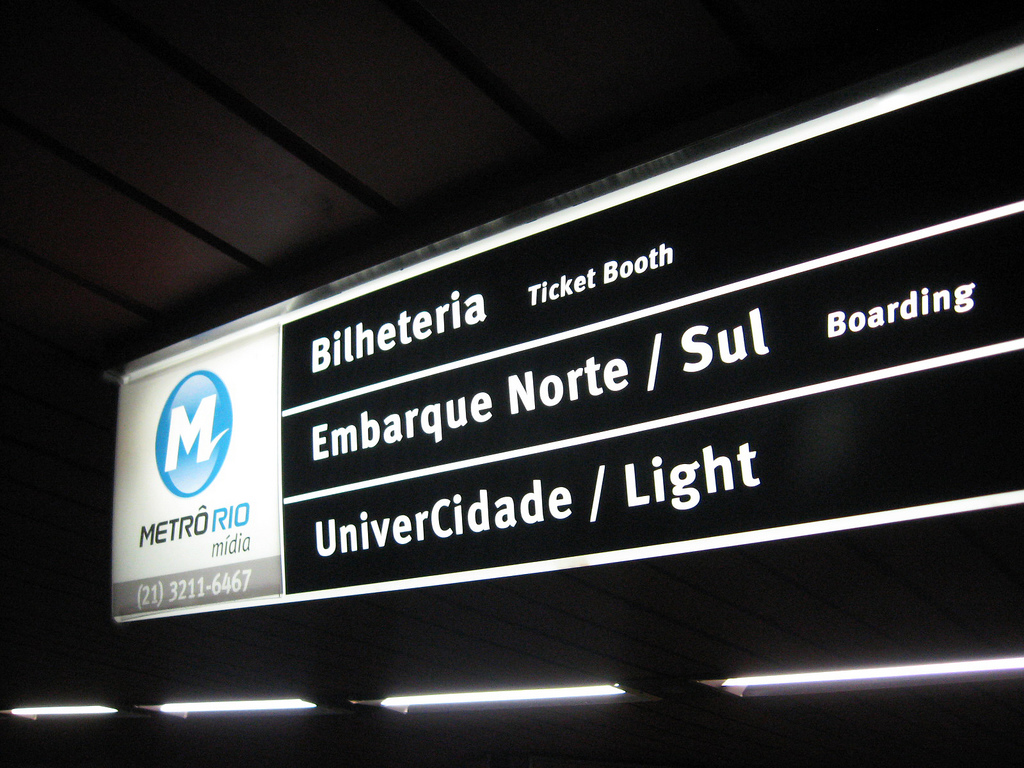
Sign in Rio’s Metro. Photo © Rodrigo Galindez licensed Creative Commons Attribution.
Those who come to Brazil with a knowledge of Portuguese from Portugal will have a much easier time in terms of communication but will also run into trouble. The differences between Portuguese from Brazil vs. Portuguese from Portugal are perhaps more acute than those between American and British English, particularly when it comes to the spoken version. Vowel and consonant sounds in Portuguese from Portugal are often distorted beyond easy recognition (even many Brazilians have difficulty understanding the Portuguese spoken by their linguistic forefathers). During its five centuries in the New World, Brazilian Portuguese has incorporated hundreds of words from other idioms.In contrast, Brazilian Portuguese is pretty much pronounced as it is written (a blessing for those trying to master it as a second language). Portuguese grammar and most of the spelling is the same in both nations, but usage and expressions can vary (for instance, in Brazil a train is a trem while in Portugal it’s a comboio).During its five centuries in the New World, Brazilian Portuguese has incorporated hundreds of words from other idioms. In the first century of Brazil’s colonial history, many newcomers adopted expressions and even spoke indigenous languages quite fluently. To this day, many place names (Ipanema, Paraíba) and names of animals (tucano [toucan]), plants (mandioca [manioc]), and fruits (abacaxi [pineapple]) are of Tupi-Guarani origin. With the proliferation of sugar cane plantations followed by the gold and diamond rushes of the 18th century, millions of Africans were brought to Brazil as slaves. They too left an important linguistic legacy. Many expressions related to specific Brazilian foods (moqueca, quindim), music (samba, maxixe), and religion (macumba, orixá)—many of Yoruba or Ewe origin—have entered the vernacular as have terms such as cafuné (caress) and moleque (brat).
In more recent times, words from other European languages entered the vernacular, specifically French and English. Terms such as metrô (subway), abajur (lamp), chique (chic) all hail from French. Meanwhile, the global influence of English in spheres such as business (commodities, layout, marketing, freelance) and technology (app, Internet, email, modem), not to mention pop culture (skinhead, junkie, vibe), has seen a growing number of English expressions infiltrate contemporary Brazilian Portuguese. The tricky thing is recognizing these homegrown idioms in their Brazilian guises: When pronounced by Brazilians, terms such as “nerd”—pronounced “nairdjee”—will often leave you scratching your head and scouring through your Portuguese dictionary in vain.
Considering the size of the country, Brazilian Portuguese is surprisingly uniform. It helps that no matter where you are, the dominant media (initially radio and today television) beamed across the land features standardized accents and vocabulary of the Southeast. Nevertheless, regionalisms abound in terms of idiomatic expressions, slang, and accents. Some of the most pronounced (and colorful) regional “dialects” are Carioca (from the city of Rio de Janeiro), Baiano (Bahia), Mineiro (central and northern Minas Gerais), Gaúcho (Rio Grande do Sul), and Caipira (interior of São Paulo, northern Paraná, southern Minas Gerais, Goiás, parts of Mato Grosso, and Mato Grosso de Sul). Although initially you might not be attuned to the differences, Brazilians themselves derive great mirth from imitating and gently making fun of each other’s accents and expressions.
Excerpted from the First Edition of Moon Living Abroad in Brazil.